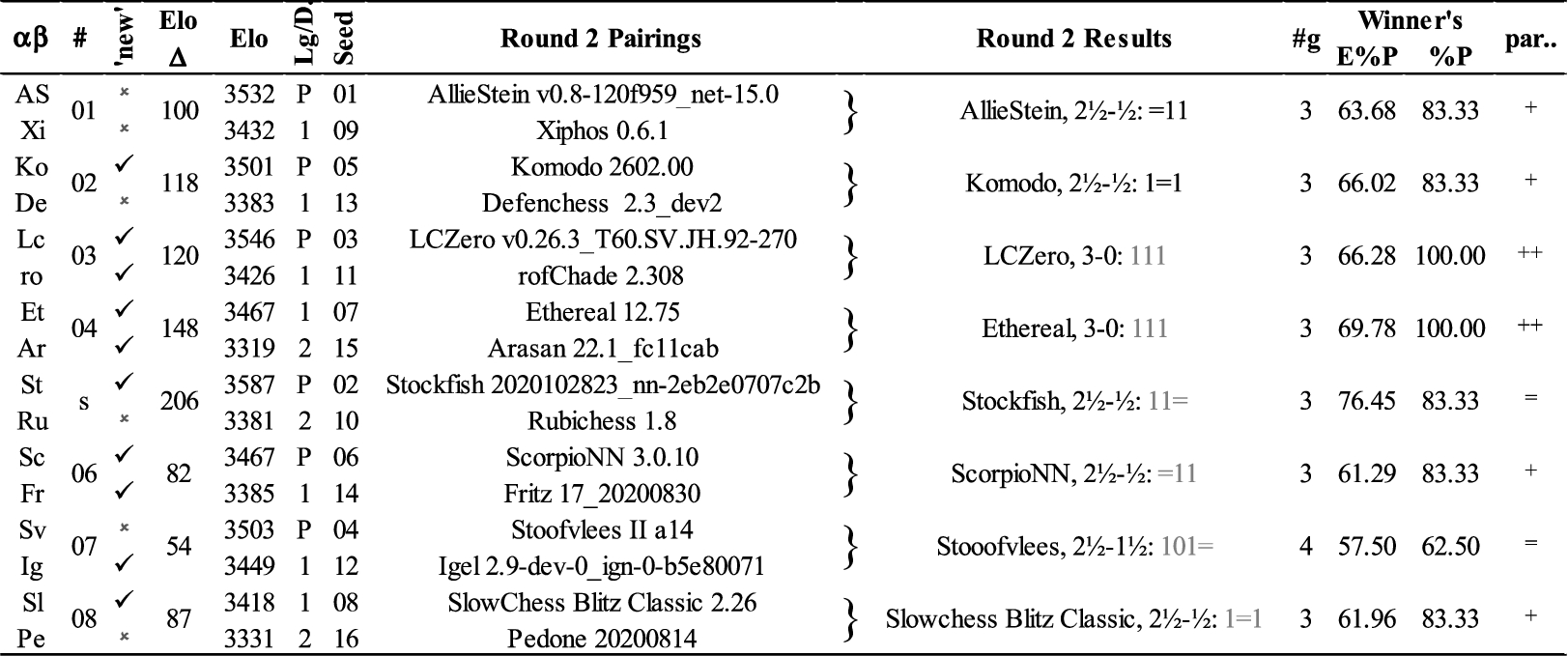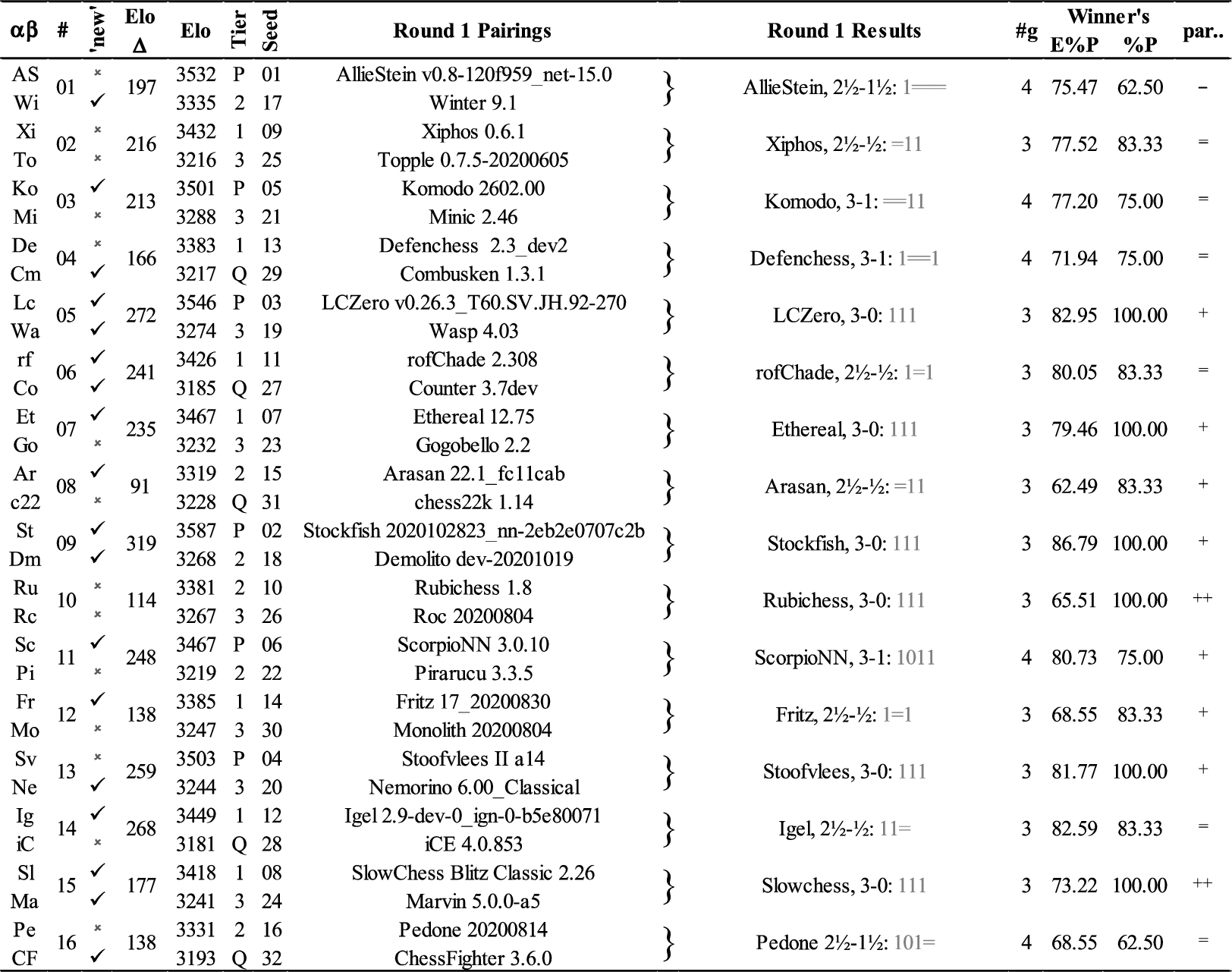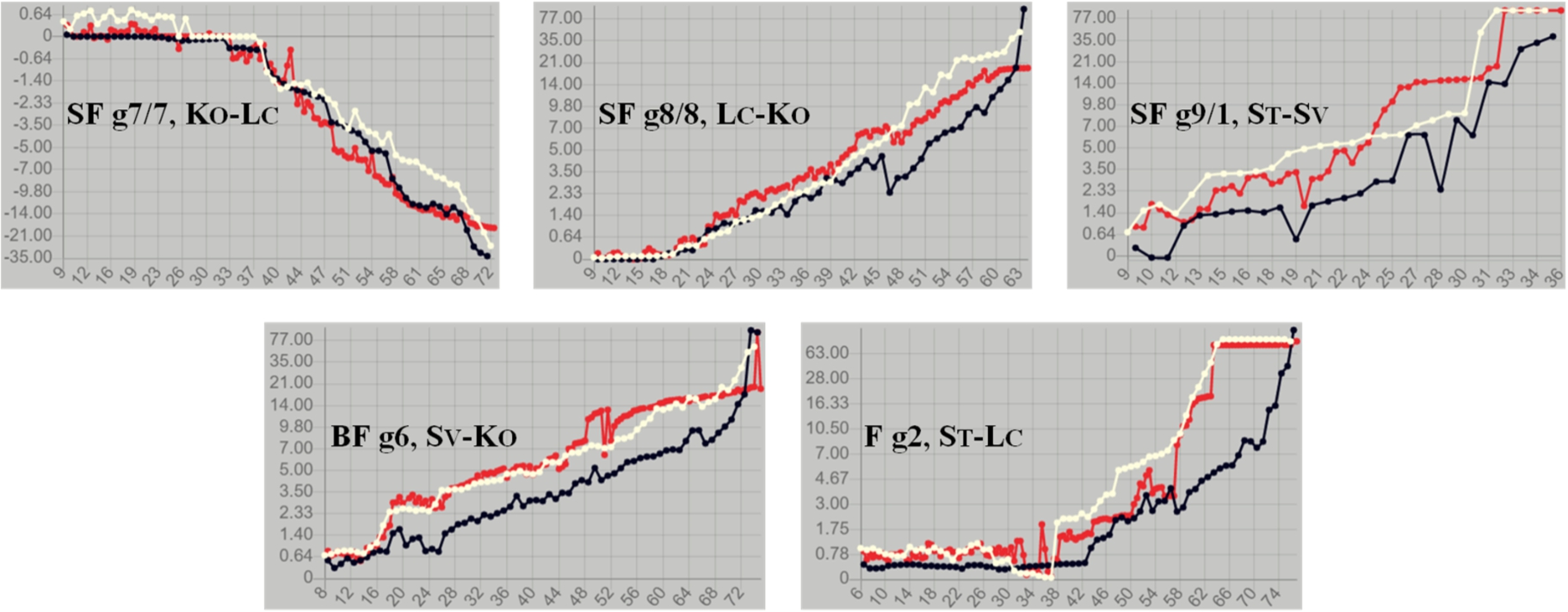TCEC Cup 7
The TCEC Cup 7 knockout event was the penultimate event of TCEC Season 19, begun on October 31st 2020 with the usual brisk Rapid tempo of
For the second time, the ‘equal distance’ pairing was used, with seed s playing seed
Second author Nelson allocated openings of 4, 8, 12 and 16 ply to the first four rounds: Jeroen Noomen’s openings for the finals came from his Superfinal books for TCEC seasons 9-19. Both chose randomly with some regard for frequency over the board providing the usual variety of play.
As in previous TCEC Cup events, interest focused on engine’s actual performance %P compared with their expected performance E%P implied by TCEC Elo difference Elo Δ. Would we see any upsets of the seedings? The accuracy of the TCEC Elos is always a matter for debate, especially for the newer engines including now the latest adoptions of NNUE technology. Eighteen engines were upgraded for this event – ‘kudos’ to their enthusiastic authors. The influence of the random openings (even when games are repeated with colours flipped) and ‘small sample size’ can also affect the match results.
1.Round 1
The higher seeds, being the first named, were again given the privilege of playing White first, increasing the chances of an opening win. They were more dominant than in previous TCEC Cup events and only five matches went to the fourth game: average Elo Δ was 206 and six engines failed to trouble the scorer. We should note that Winter did better than expected with three draws against Cup holder AllieStein and that Pirarucu and ChessFighter managed to win a game before being eliminated.
2.Round 2
Ten ‘refreshed’ engines proceeded to round 2: six were as in the TCEC19 league event. Again, there were no surprise match results so the top eight seeds proceeded to the quarterfinals, see Table 2. The NNUE-improved Igel won against Stoofvlees before capitulating but otherwise, the favourites won at the first attempt in three games despite average Elo difference narrowing to 114.
Table 2
TCEC Cup 7: round two results from the winner’s perspective

3.The quarter-finals, semi-finals, Bronze final and final
There were several surprises in the four matches of the quarterfinals. First, Komodo took its chance with its first White, see Table 3. Two moves too late, at move 35, the cup holder AllieStein realised that all was lost. It did not have a reply in the remaining two games. The outstanding performance of TCEC Cup 7 was certainly that ScorpioNN took Stockfish to eight games, holding the multiple TCEC champion to six draws before losing ground with 16
In the semi-finals, it was Leela’s turn to be favourite in what was expected to be a close match. Komodo was again the opponent and once more we were treated to six opening draws. Then matters were concluded in the most dramatic fashion, see Table 4. Leela unexpectedly won both sides of a Benoni though it is not clear that the mandated opening of 16 ply was responsible for this. The evaluation curves of the semi-final’s three decisive games are shown in Fig. 2: the red line is from the kibitzing Crystal. The first of these suggests that Komodo lost ground around move 41; the second suggests that Komodo, now Black, was gradually overpowered in a more strategic way. Figure 3 gives positions from the last five decisive games where the win was arguably ‘sighted on the horizon’ by at least the winner. Readers and their own chess engines may need more convincing but then, they are not driving their search and evaluation processes with the same computing power.
Table 3
TCEC Cup 7: quarterfinal results from the winner’s perspective

The play-off for the Bronze medal between Stoofvlees and Komodo involved adjacent seeds 4 and 5 with an Elo difference of only 2. Statistically then, it was the hardest match of the event to predict, especially as Stoofvlees has treated us to both the most spectacular wins and the most horrendous blunders. However, here, the two contestants conjured five draws against the odds before Stoofvlees finally broke through. Again, Figs 2 and 3 show the game trend and a key position.
Table 4
TCEC Cup 7: semi-final results from the winner’s perspective

Fig. 3.
‘Win on horizon’ positions in the last five decisive games: Semi-finals, a) game 7 Ko-Lc pos. 41b, (b) g8 Lc-Ko p32w, (c) g9 St-Sv p13w; (d) Bronze final g6 Sv-Ko p17w; (e) Final g2 St-Lc p37b.

After a suspensful pause, while the invaluable operations manager ‘Aloril’ checked the computer platforms and waited for a prime-time television spot, the match for the seventh TCEC Cup commenced. Stockfish was obviously the favourite after its fine all-round performance in the TCEC19 Superfinal, especially in losing only one mini-match. Leela had to get lucky and it did not, losing its opening game as Black, see Table 5. Congratulations once again to Stockfish which, in this TCEC Season took both titles. Its team is entitled to eat all the pies. NNUE is setting new standards.
Table 5
TCEC Cup 7: the Stoofvlees – Komodo play-off and the Stockfish – Leela Chess Zero final

4.In conclusion
The TCEC Cup 7 knockout event was another enjoyable celebration of chess. It is worth reminding ourselves of the fact that, even at this Rapid tempo, these engines are in the main still playing better than the best Grandmasters in Classic tempo. A TCEC engine with this platform on Blitz tempo against a top GM team on Classic tempo would surely make for an interesting game and commentary.
Once again, our thanks to all who made this TCEC Season possible, engaging and entertaining. All the games are available with analysis and kibitzer-engine commentary (TCEC, 2020). The pgn files of the games are also available with the decisive games played out (Haworth and Hernandez, 2020d). The usual tableau of shortest/longest games, highlighting the long and unexpected round 1 draw between Winter and AllieStein, is given in Table 6 below.
Table 6
The shortest and longest 1-0, drawn and 0-1 games in each phase of TCEC Cup 7: ‘35/2’ in row 1, column 2 for example means ‘game 35 in the pgn, game 2 in the match’

Notes
1 In these tables, the first-named engine played White first except where indicated by a ‘*’. Alongside the ‘%P’ column, ‘+’ (‘–’) indicates an unexpected excess (shortfall) of a ½-point in the winner’s score. ‘#g’ ≡ number of games.
References
1 | CPW (2020). https://tinyurl.com/icga046. Biographies of chess engines, authors and developers. |
2 | Haworth, G.McC. & Hernandez, N. ((2020) a). The 18th Top Chess Engine Championship: TCEC18. ICGA Journal, 42: (2–3), 211–222. http://centaur.reading.ac.uk/91839/ adds pgn files and further data. doi:10.3233/ICG-200160. |
3 | Haworth, G.McC. & Hernandez, N. ((2020) b). TCEC Cup 6. ICGA Journal, 42: (2–3), 237–241. http://centaur.reading.ac.uk/91840/ adds pgn files and further data. doi:10.3233/ICG-200159. |
4 | Haworth, G.McC. & Hernandez, N. ((2020) c). The 19th Top Chess Engine Championship, TCEC19. ICGA Journal, 42: (4), 295–305. http://centaur.reading.ac.uk/93815/ adds pgn files and further data. |
5 | Haworth, G.McC. & Hernandez, N. ((2020) d). TCEC Cup 7. ICGA Journal, 42: (4), 321–325. http://centaur.reading.ac.uk/93816/ adds pgn files and further data. |
6 | TCEC (2020). https://tcec-chess.com/#x=archive. The TCEC archive site. |







